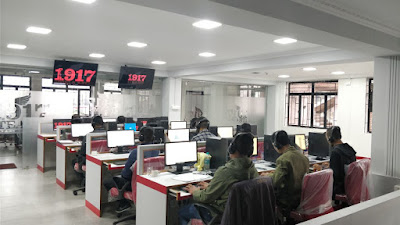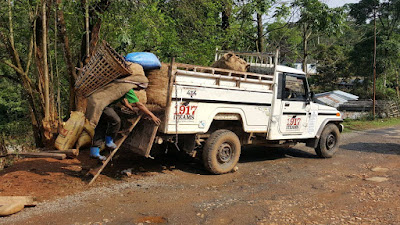 |
| Photo 1: Shri. Conrad K. Sangma, Hon'ble Chief Minister inaugurating the Webinar in presence of Chief Secretary, Government of Meghalaya |
The Government of Meghalaya in
collaboration with various National Institutes, product development Institutes,
academic Institutes, Export Associations, Traders based in Shillong and other States
of the country and innovators in the agriculture and allied sector organised a
two day webinar in an effort to prepare a roadmap for agriculture and allied
sectors in Meghalaya for a 5 years, 10 years and 20 years.
The Webinar entitled “Meghalaya’s Agri
Vision 2040,” the first such online event of this scale was inaugurated by the
Chief Minister of Meghalaya, Shri Conrad K. Sangma on 10th July, 2020 in the
presence of the Chief Secretary to the Government of Meghalaya, Shri M. S. Rao,
Principal Secretary Agriculture Dr.S.Ahaamed and departmental officials. The
Webinar was also participated by various products specific institutions,
academia, Scientists and practitioners, such as National Institute of
Immunology, CGSIR, ICAR, CAU, NEHU (Tura campus), NRC Banana Kochi, Jackfruit
processing Centre, National Institute for Mushroom Solan, Himachal Pradesh,
Sadhana Forest, CPRS, CIMAP, CIH, NCCD and local entrepreneurs, logistic
managers like Rapsang group, Weilabha Meat Processing discussed and deliberated
the way forward for the agricultural and allied sector in Meghalaya. The
sessions included product specific issues for rice, maize, lakadong turmeric,
local fruits and vegetables, dairy sector, poultry sector, piggery sector,
fishery and new technology in agriculture and horticulture like hydroponics.
The United Nations’ first ten
innovators winner and Managing Director of Future Farms, Shri Gopal while
addressing the webinar offered to establish a centre in Shillong to help
promote and support young entrepreneurs to take up hydroponics in Meghalaya.
Dr. S. Uma, Director of NRC, offered assistants in setting up a banana
processing center in Garo Hills.
 |
| Photo 2: A View of the Participants of the Webinar conducted on Cisco WEBEX |
The 2 days online Webinar witnessed a
total participation of 1509 participants from all over the country and also
from abroad clocking a total of 991 online minutes on both days. The first day
recorded 832 participants while the second day recorded 675 participants. The cumulative
participant’s minutes clocked by all the participants of the 2 days webinar total
to a whopping 95,384 minutes. This is indicative of the high level of interest that
the webinar has managed to enthrall the participants, from Scientists, Subject
Matter Specialists, Practitioners, State Government officials, Officers of the Department
of Agriculture and allied sectors, Farmers, Citizens, Business people, Academician,
Students and Enthusiasts.
One of the largest exporters of honey to Europe and USA,
Shri S. Joseph of Malabar Honey, offered free training to the apiary farmers of
the State and the training session has been scheduled on 16th July, 2020. In
the session conducted by the Director of the National Institute of Immonology,
Dr. Amalya Panda, agreed to take up a project for nutraceuticals and medicinal
value analysis of products such as Lakadong turmeric and mushrooms grown in the
state. Professor Sahoo of Delhi University spoke on the various entrepreneurial
avenues available on nutraceuticals in the State of Meghalaya and Director of
ICAR Dr. Pattanayak spoke on improving rice innovation with a time bound plan
and stated that certain tools and machinery suitable for hilly states has
arrived at ICAR, Barapani and will be distributed to rice farmers of the state
soon. Speaking on the bamboo sector, experts from National Institute of Design,
Ahmedabad, Prof. Solanki and Shri Shivraj of the renowned NGO, Uravu, commented
on the various potentialities that this sector possesses in the state of
Meghalaya. Speaking during the webinar, Dr. Mohanty, Asia and Regional Head of
the International Potato Centre, showed interest in collaborating with the
State in research and development in the potato sector, while the IFAD Country
head Ms Rasha Omar, highlighted the possible interface for collaborations with
the development aspiration of the State.
 |
| Photo 3: Participants from Ri-Bhoi District |
The highlight of the event was the interaction of the
progressive farmers of the state who attended the webinar from their respective
districts, and had their queries addressed by the subject matter specialists.
The Webinar was also participated by
the Hills Farmers Union represented by the President and Secretary respectively.
They have also expressed their views that farmers need quality seeds, inputs,
manures, cool chain refer vans and market linkages. They also expressed that technology
led development of farmers is the need in order to move ahead in the years
ahead.
Shri. K.N Kumar(Retd IAS) and Chairman
Meghalaya Farmers Commission who also joined the webinar from Hyderabad stated that
farmers in Meghalaya are loosely organised and this leads to poor collectivisation.
He also opined that the reach of the State Government and the Department
schemes is not up to the mark and there is much more ground to be covered. He
expressed his views that farmers should not sell only raw produces but should
be encouraged and capacitated to sell only value added products in order to get
better value to their hard work.
Subsequent to this, it was decided that
the Department will bring up a compendium which is sector specific with detailed
interactions with all stakeholders, practitioners, experts and farmers. The
wrap up session was held on 11th July, 2020 and was attended by the farmer’s
commission, Hills Farmers Union, and various stakeholders and was addressed by
the Principal Secretary of Agriculture Shri P. Shakil Ahamed. Overall, the
webinar was highly interactive and interesting which facilitated a forum for
the farmers, practitioners, innovators and academia and policy makers to openly
probe ideas, discuss issues and come to a conclusion in preparing a time-bound,
specific and measurable roadmap for the State of Meghalaya, which will include
a short term, medium term and long term strategy for the State.
 |
| Photo 4: Participants attending from East Garo Hills district of the State |
On the second day, the Principal Secretary
Agriculture, Dr. S.Ahamed, IAS in his concluding remarks thanked all the
participants who attended the webinar on both days, He said that without
farmers, we are nothing and the time now is to go back to basics. As a State we
need to be self sufficient in food production and farmers are the fulcrum of the
State’s strategy to achieve this goal. He stressed on the need to make farming
remunerative, sustainable and profitable.
(With inputs from DIPR and Department
of Agriculture & Farmers’ Welfare, Meghalaya)









